Application of an Online-Coupled Regional Climate Model, WRF-CAM5, over East Asia for Examination of Ice Nucleation Schemes: Part II. Sensitivity to Heterogeneous Ice Nucleation Parameterizations and Dust Emissions
Abstract
:1. Introduction
2. Sensitivity Simulation Design
3. Sensitivity to Heterogeneous Ice Nucleation Parameterizations
3.1. Sensitivity of Ice Nucleation Related Parameters to INPs
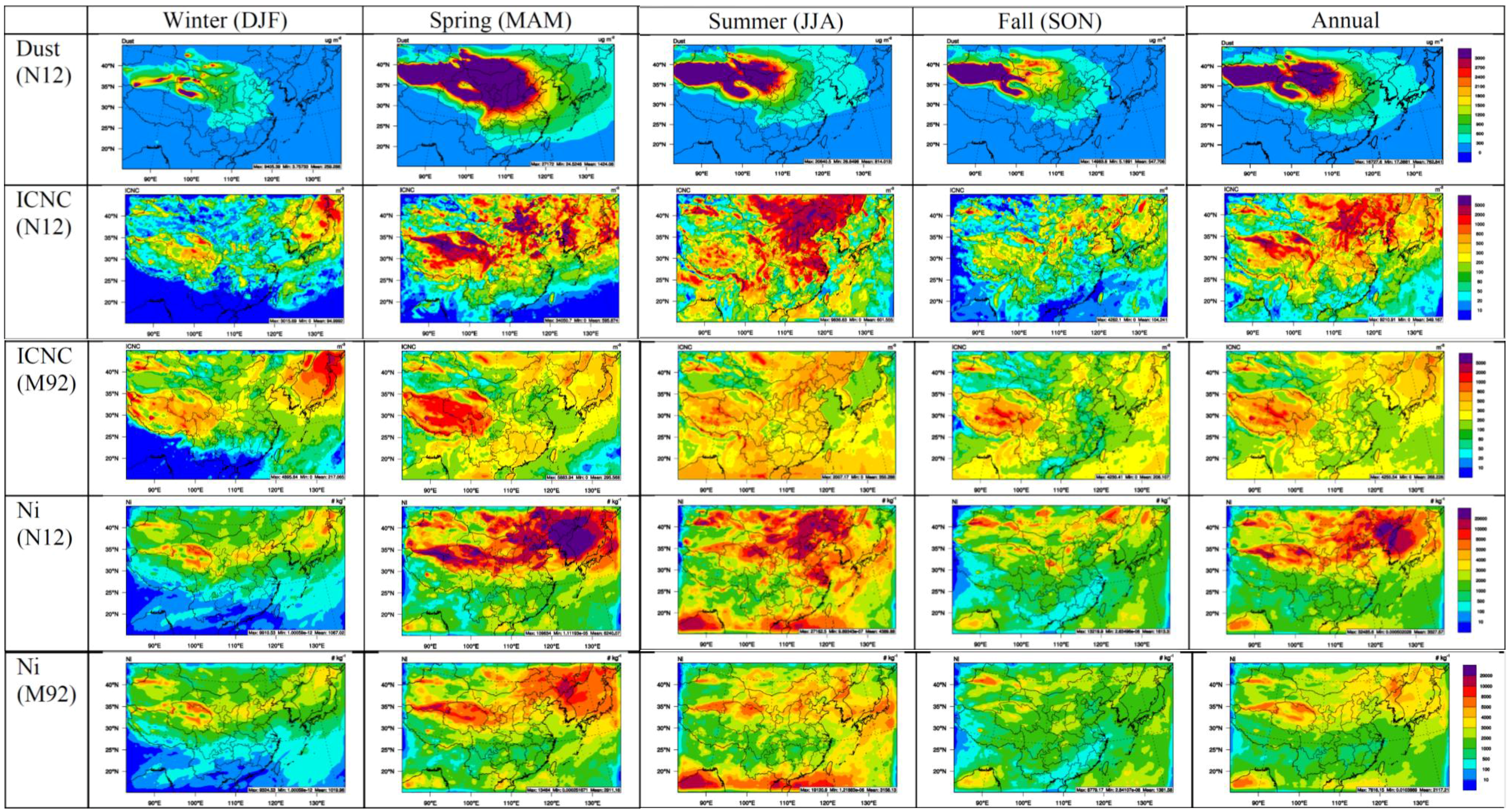
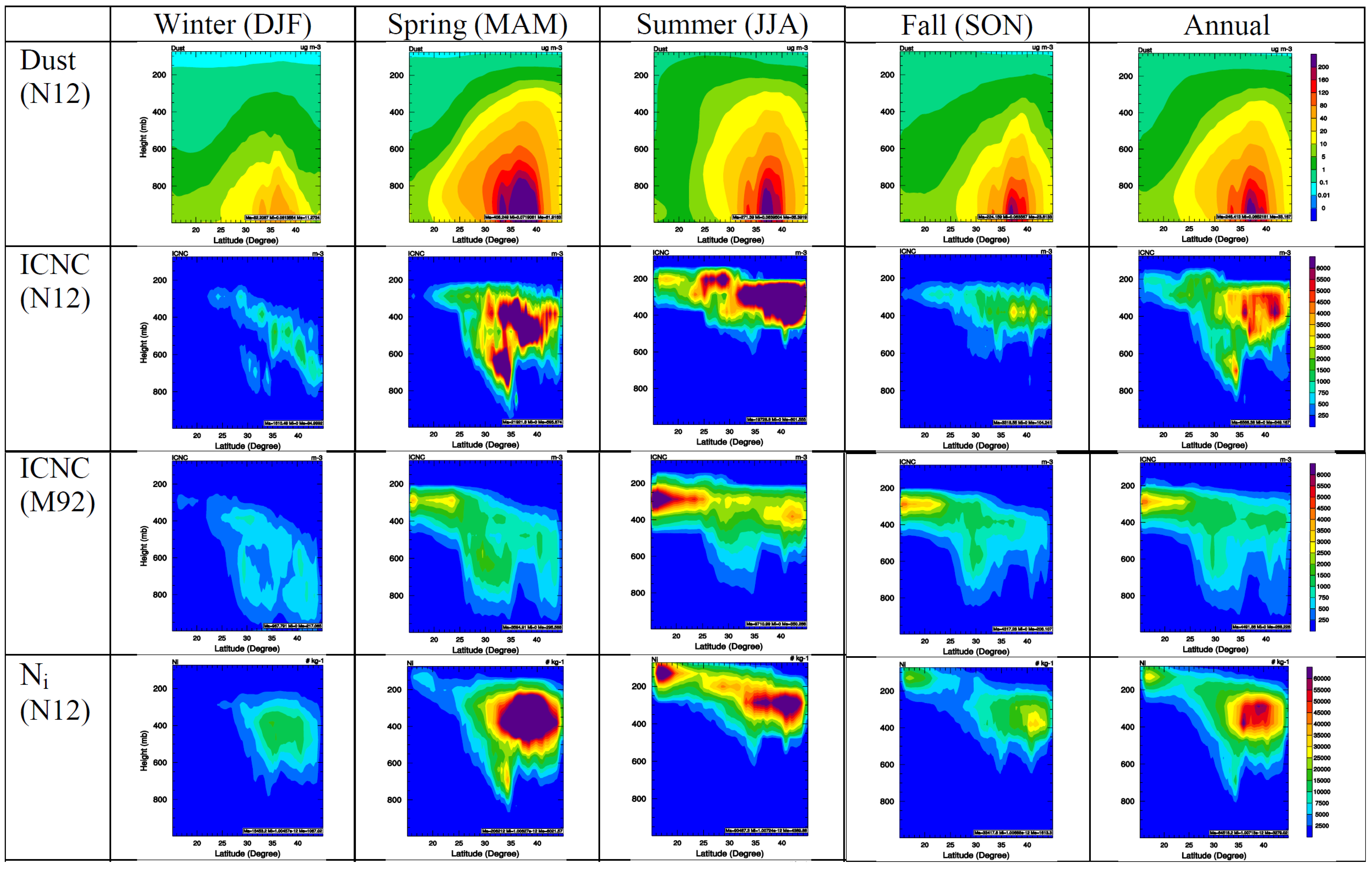
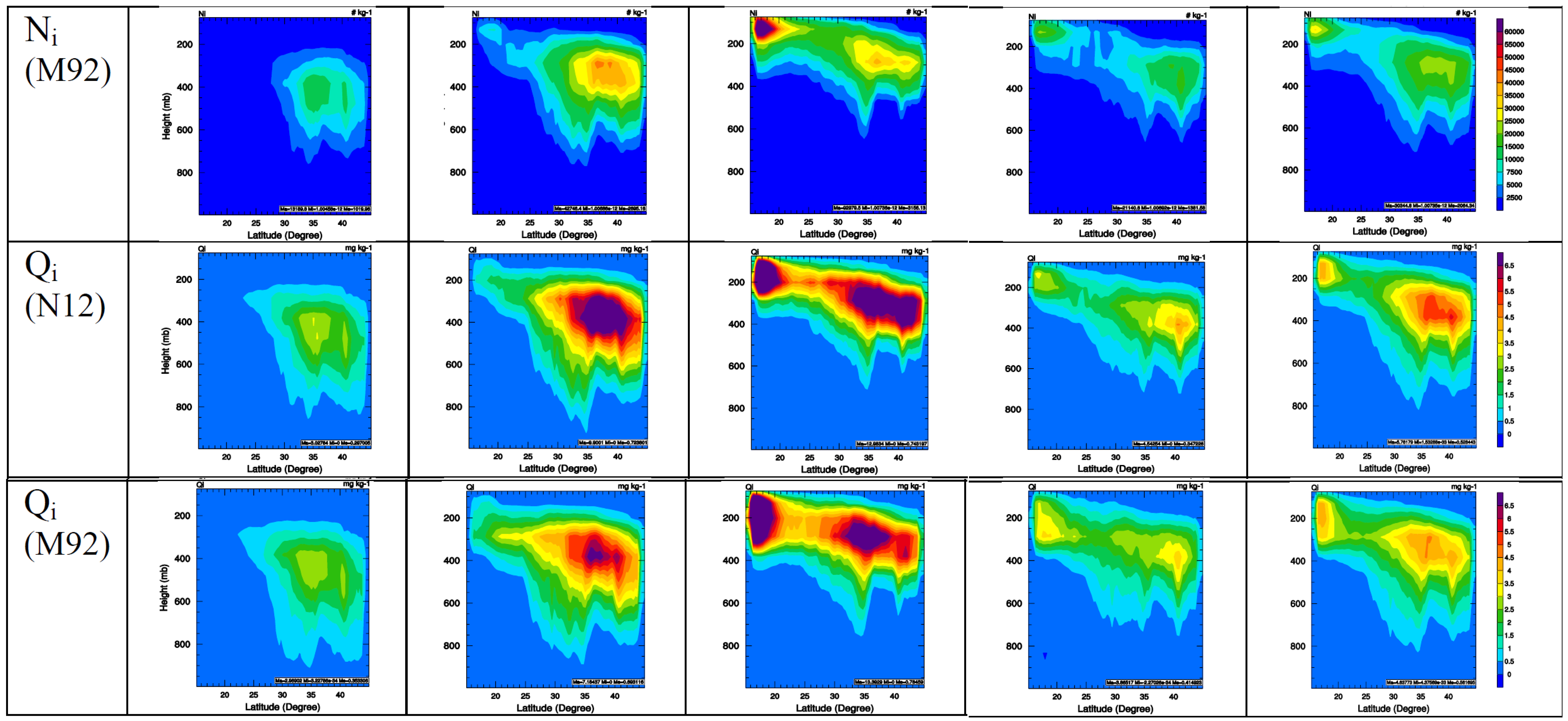
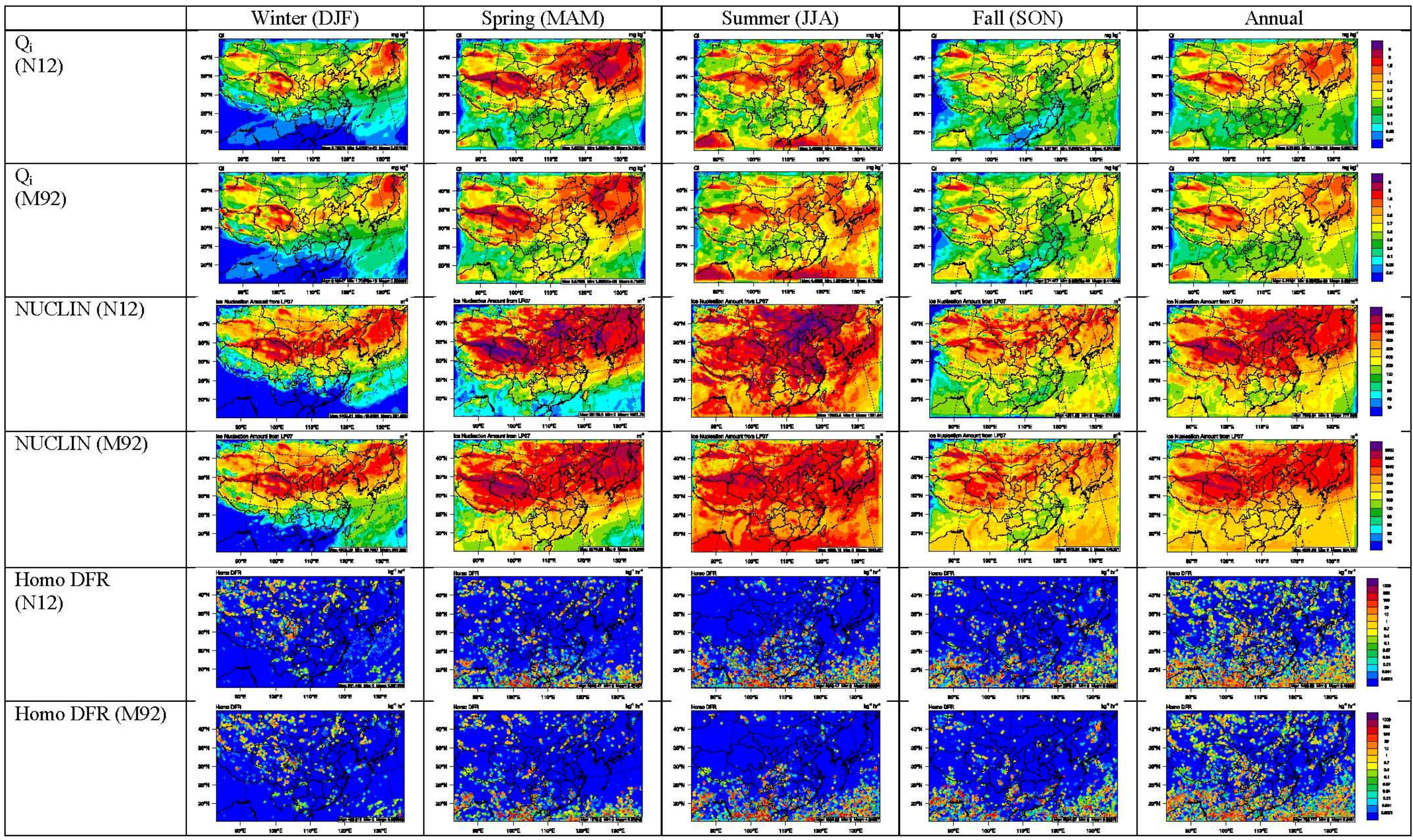
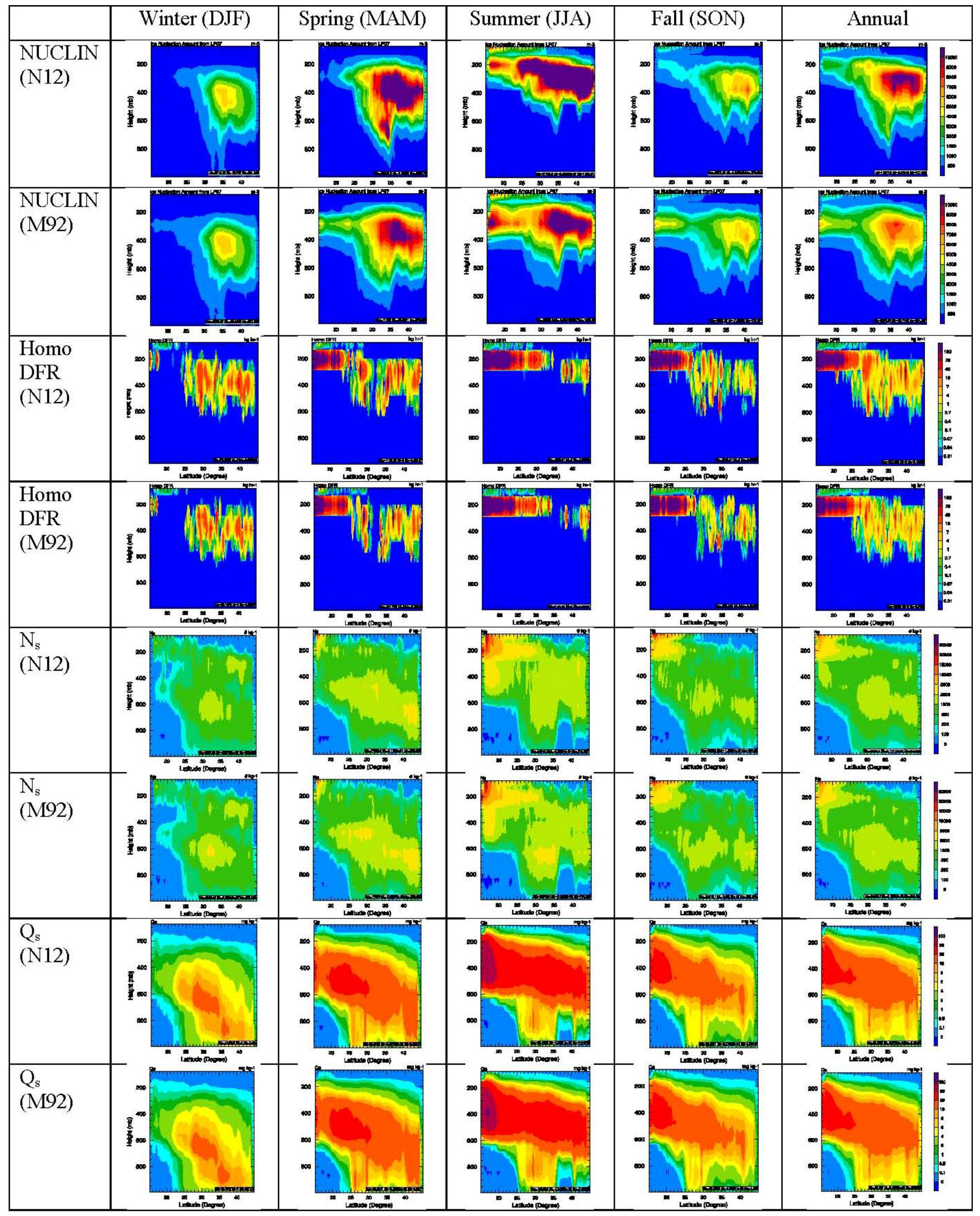
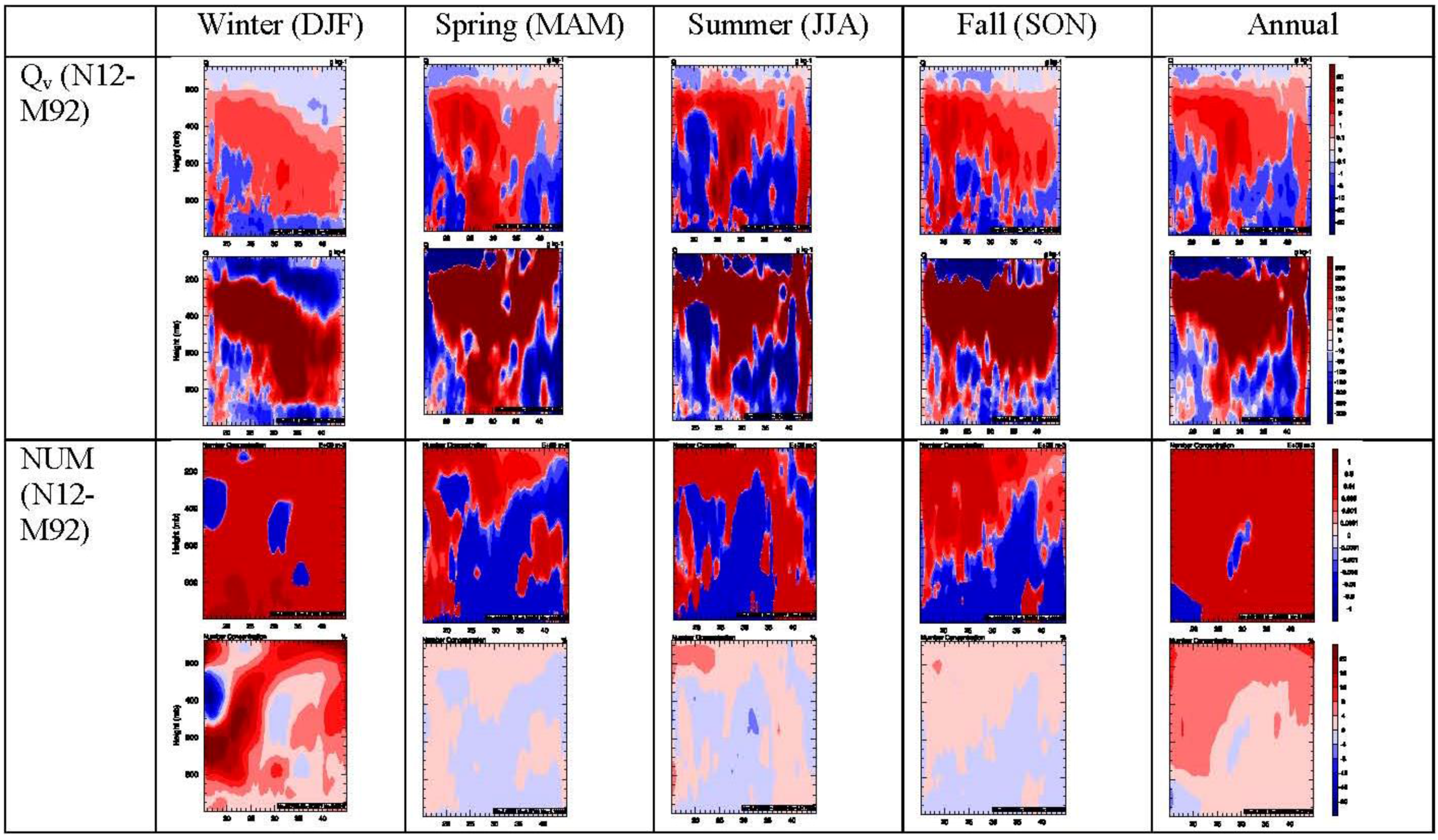
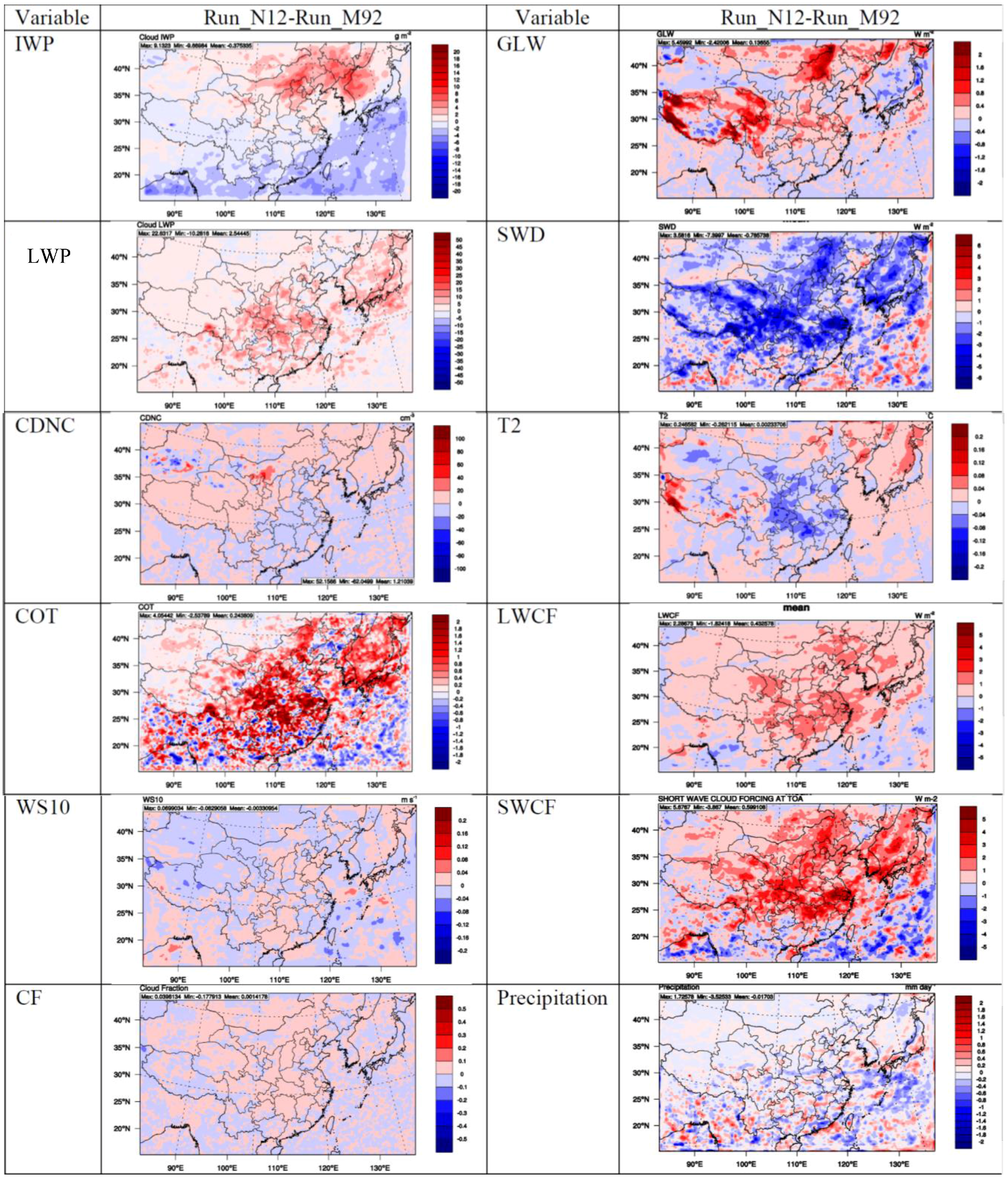
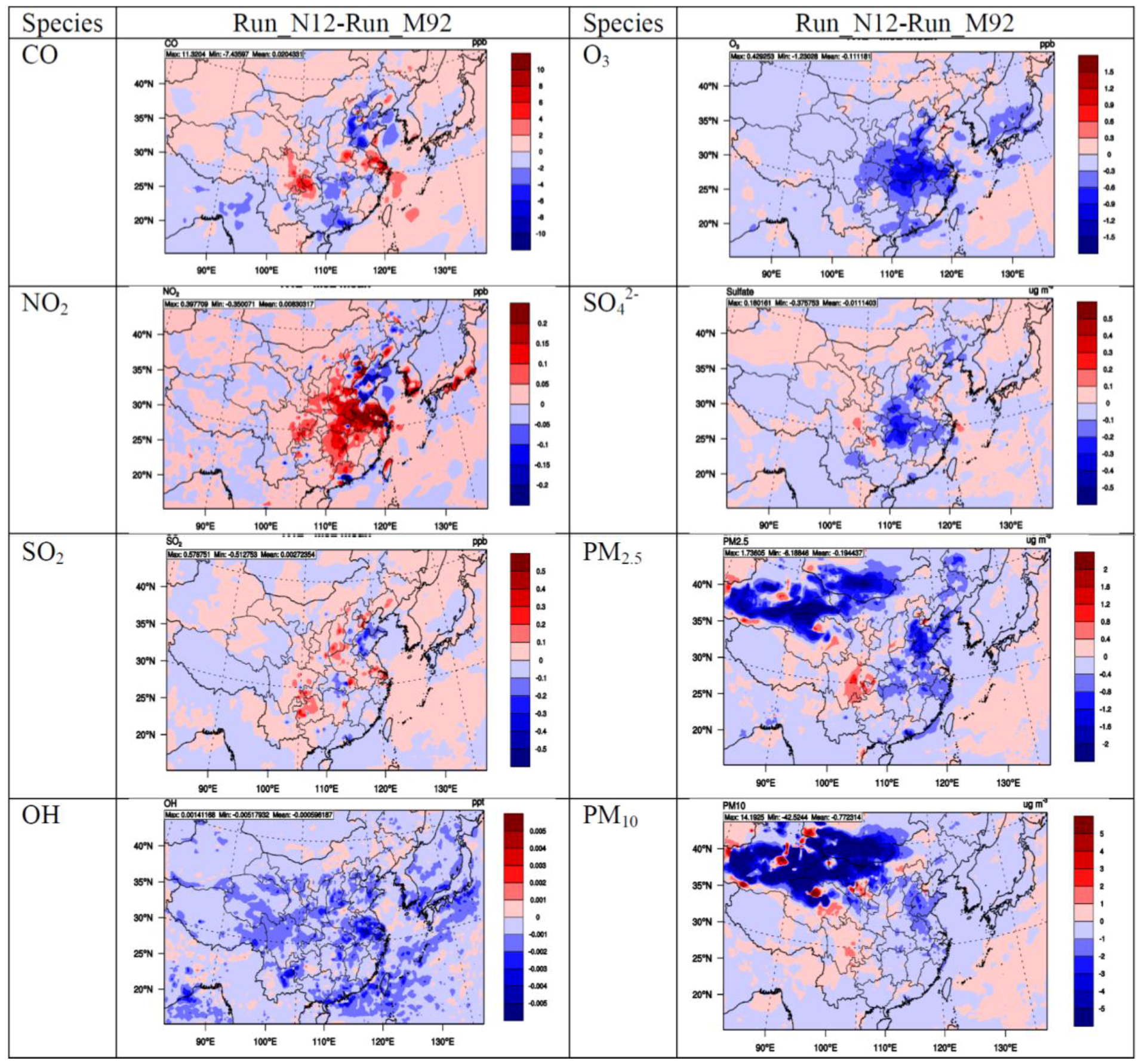
3.2. Model Performance of N12 and Its Comparison with That of M92
4. Role of Dust Particles in Cloud and Radiation through Direct and Indirect Effects
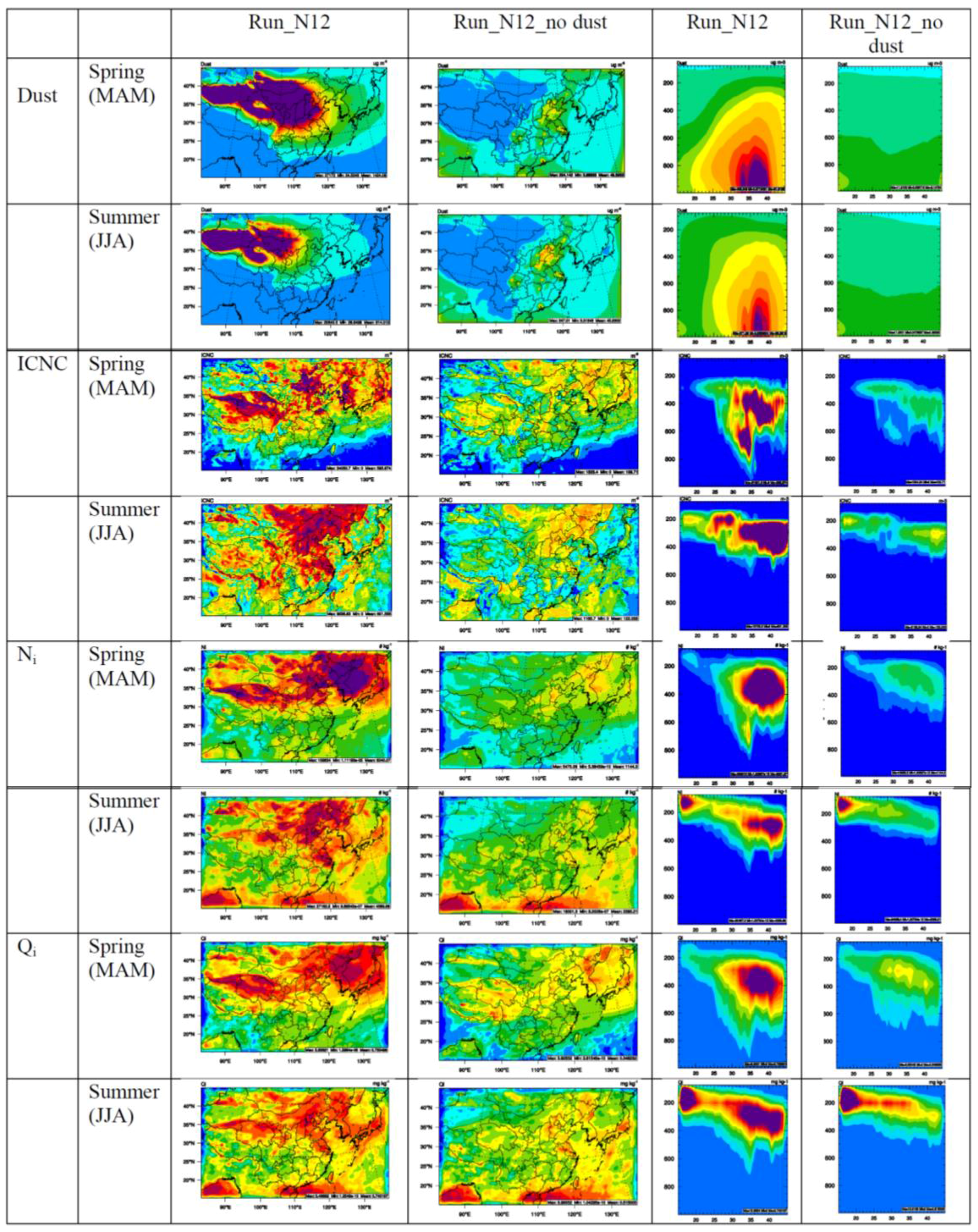
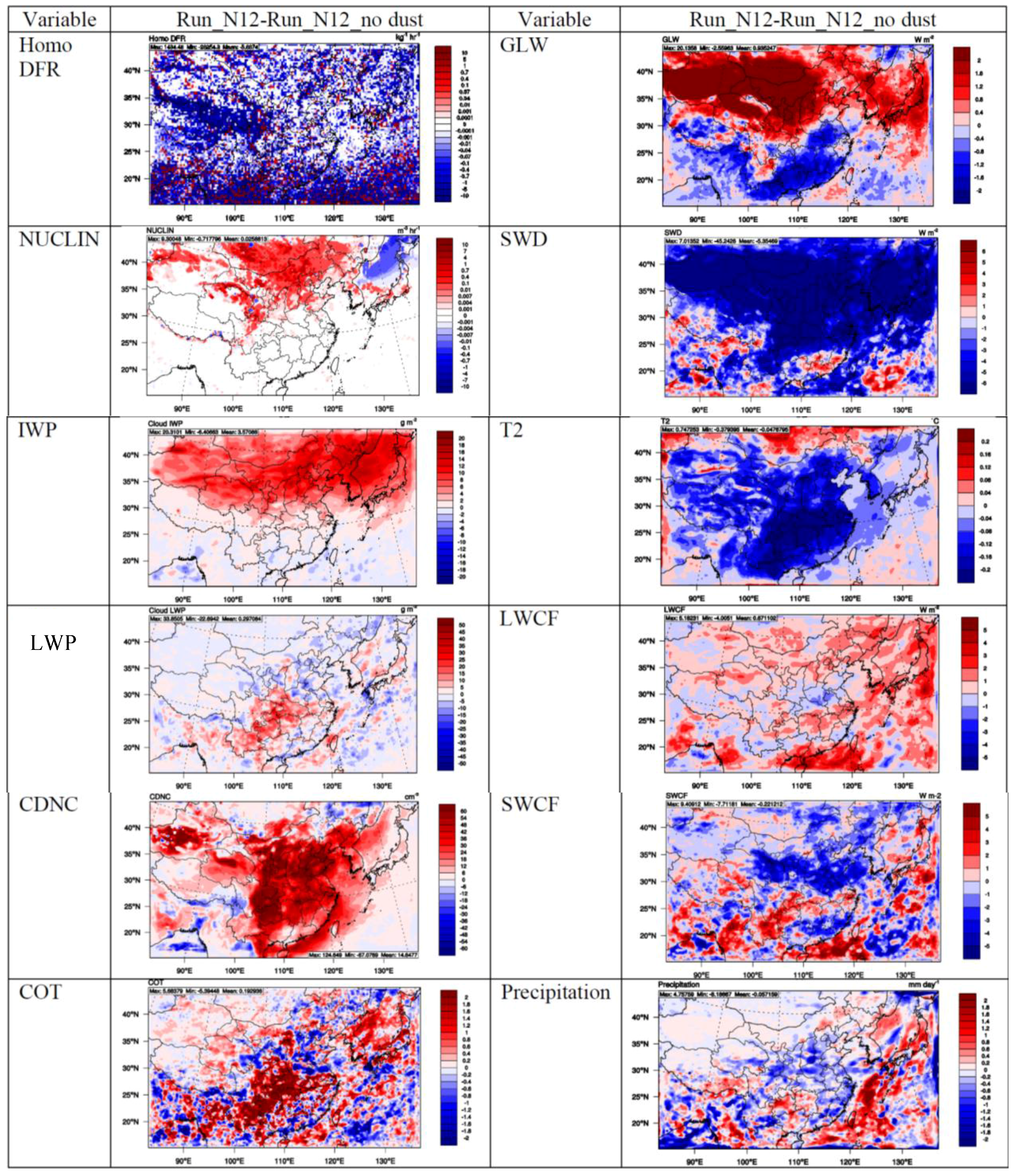
5. Summary and Conclusions
Acknowledgments
Author Contributions
Conflicts of Interest
References
- Niemand, M.; Mohler, O.; Vogel, B.; Vogel, H.; Hoose, C.; Connolly, P.; Klein, H.; Bingemer, H.; DeMott, P.; Skrotzki, J.; Leisner, T. A particle-surface-area-based parameterization of immersion freezing on desert dust particles. J. Atmos. Sci. 2012, 69, 3077–3092. [Google Scholar] [CrossRef]
- Meyers, M.P.; DeMott, P.J.; Cotton, W.R. New primary ice-nucleation parameterizations in an explicit cloud model. J. Appl. Meteorol. 1992, 31, 708–721. [Google Scholar] [CrossRef]
- Pruppacher, H.R.; Klett, J.D. Microphysics of Clouds and Precipitation; Atmospheric and Oceanographic Sciences Library; Kluwer Academic Publishers: Dordrecht, the Netherlands, 1997. [Google Scholar]
- Morrison, H.; Gettelman, A. A new two-moment bulk stratiform cloud microphysics scheme in the Community Atmosphere Model, Version 3 (CAM3). Part I: Description and numerical tests. J. Clim. 2008, 21, 3642–3659. [Google Scholar] [CrossRef]
- Rogers, R.R.; Yau, M.K. A Short Course in Cloud Physics; Pergamon Press: Oxford, UK, 1989. [Google Scholar]
- DeMott, P.J.; Prenni, A.J.; Liu, X.; Kreidenweis, S.M.; Petters, M.D.; Twohy, C.H.; Richardson, M.S.; Eidhammer, T.; Rogers, D.C. Predicting global atmospheric ice nuclei distributions and their impacts on climate. Proc. Natl. Acad. Sci. USA 2010, 107, 11217–11222. [Google Scholar] [CrossRef] [PubMed]
- Murray, B.J.; O’Sullivan, D.; Atkinson, J.D.; Webb, M.E. Ice nucleation by particles immersed in supercooled cloud droplets. Chem. Soc. Rev. 2012, 41, 6519–6554. [Google Scholar] [CrossRef] [PubMed]
- Fan, J.; Ovtchinnikov, M.; Comstock, J.; McFarlane, S.A.; Khain, A. Ice formation in Arctic mixed-phase clouds—Insights from a 3-D cloud-resolving model with size-resolved aerosol and cloud microphysics. J. Geophys. Res. 2009. [Google Scholar] [CrossRef]
- Fan, J.; Leung, L.R.; DeMott, P.J.; Comstock, J.M.; Singh, B.; Rosenfeld, D.; Tomlinson, J.M.; White, A.; Prather, K.A.; Minnis, P.; Ayers, J.K.; Min, Q. Aerosol impacts on California winter clouds and precipitation during CalWater 2011: Local pollution versus long-range transported dust. Atmos. Chem. Phys. 2014, 14, 81–101. [Google Scholar] [CrossRef]
- Khain, A.; Rosenfeld, D.; Pokrovsky, A. Aerosol impact on the dynamics and microphysics of deep convective clouds. Q. J. R. Meteorol. Soc. 2005, 131, 2639–2663. [Google Scholar] [CrossRef]
- Fan, J.; Zhang, R.; Li, G.; Tao, W.-K. Effects of aerosols and relative humidity on cumulus clouds. J. Geophys. Res. 2007. [Google Scholar] [CrossRef]
- Fan, J.; Leung, L.R.; Rosendeld, D.; Chen, Q.; Li, Z.; Yu, H.; Zhang, J. Microphysical effects determine macrophysical response for aerosol impacts on deep convective clouds. Proc. Natl. Acad. Sci. USA 2013. [Google Scholar] [CrossRef] [PubMed]
- Wegener, A. Thermodynamik der Atmosphare; J. A. Barth: Leipzig, Poland, 1911. [Google Scholar]
- Bergeron, T. On the physics of clouds and precipitation. In Proces Verbaux de l’Association de Meteorologie; International Union of Geodesy and Geophysics: Prague, Czech, 1935; pp. 156–178. [Google Scholar]
- Findeisen, W. Kolloid-meteorologische Vorg€ange bei Neiderschlags-bildung. Meteorol. Z. 1938, 55, 121–133. [Google Scholar]
- DeMott, P.J. An exploratory study of ice nucleation by soot aerosols. J. Appl. Meteorol. 1990, 29, 1072–1079. [Google Scholar] [CrossRef]
- Chen, Y.; KreidenweisL, S.M.; McInnes, M.; Rogers, D.C.; DeMott, P.J. Single particle analyses of ice nucleating aerosols in the upper troposphere and lower stratosphere. Geophys. Res. Lett. 1998, 25, 1391–1394. [Google Scholar] [CrossRef]
- Heintzenberg, J.; Okada, K.; Strom, J. On the composition of non-volatile material in upper tropospheric aerosols and cirrus crystals. Atmos. Res. 1996, 41, 81–88. [Google Scholar] [CrossRef]
- Targino, A.C.; Krejci, R.; Noone, K.J.; Glantz, P. Single particle analysis of ice crystal residuals observed in orographic wave clouds over Scandinavia during INTACC experiment. Atmos. Chem. Phys. 2006, 6, 1977–1990. [Google Scholar] [CrossRef]
- Sokolik, I.N.; Toon, O.B. Direct radiative forcing by anthropogenic airborne mineral aerosol. Nature 1996, 381, 681–683. [Google Scholar] [CrossRef]
- Sassen, K. Indirect climate forcing over the western US from Asian dust storms. Geophys. Res. Lett. 2002, 29. [Google Scholar] [CrossRef]
- Prenni, A.J.; DeMott, P.J.; Kreidenweis, S.M.; Harrington, J.Y.; Avramov, A.; Verlinde, J.; Tjernström, M.; Long, C.N.; Olsson, P.Q. Can ice-nucleating aerosols affect arctic seasonal climate? B Am. Meteorol. Soc. 2007, 88, 541–550. [Google Scholar] [CrossRef]
- Bigg, E.K. The formation of atmospheric ice crystals by the freezing of droplets. Q. J. R. Meteorol. Soc. 1953, 79, 510–519. [Google Scholar] [CrossRef]
- Fletcher, N.H. The Physics of Rainclouds; Cambridge University Press: Cambridge, UK, 1962. [Google Scholar]
- Cotton, W.; Tripoli, G.; Rauber, R.; Mulvihill, E. Numerical simulation of the effects of varying ice crystal nucleation rates and aggregation processes on orographic snowfall. J. Clim. Appl. Meteorol. 1986, 25, 1658–1680. [Google Scholar] [CrossRef]
- Phillips, V.T.J.; DeMott, P.J.; Andronache, C.; Pratt, K.A.; Prather, K.A.; Subramanian, R.; Twohy, C. Improvements to an empirical parameterization of heterogeneous ice nucleation and its comparison with observations. J. Atmos. Sci. 2013, 70, 378–409. [Google Scholar] [CrossRef]
- Liu, X.H.; Penner, J.E.; Ghan, S.; Wang, M. Inclusion of ice microphysics in the NCAR Community Atmospheric Model Version 3 (CAM3). J. Clim. 2007, 20, 4526–4547. [Google Scholar] [CrossRef]
- Young, K.C. The role of contact nucleation in ice phase initiation. J. Atmos. Sci. 1974, 31, 768–776. [Google Scholar] [CrossRef]
- Fan, J.; Lim, K.-S.; Leung, L.R.; Zhao, C.; Ma, P.-L.; Zhang, K.; Liu, X.-H.; Yang, Q. Impacts of Uncertainty in Ice Nucleation Parameterizations and Dust on Modeling Deep Convective Clouds and Precipitation; The 2014 ASR Fall Working Groups: Bethesda, MD, USA, 2014. [Google Scholar]
- Zender, C.S.; Bian, H.; Newman, D. Mineral Dust Entrainment and Deposition (DEAD) model: Description and 1990s dust climatology. J. Geophys. Res. 2003. [Google Scholar] [CrossRef]
- Zhang, G.J.; McFarlane, N.A. Sensitivity of climate simulations to the parameterization of cumulus convection in the Canadian Climate Centre General Circulation Model. Atmos. Ocean 1995, 33, 407–446. [Google Scholar]
- Song, X.; Zhang, G.J. Microphysics parameterization for convective clouds in a global climate model: Description and single column model tests. J. Geophys. Res. 2011. [Google Scholar] [CrossRef]
- DeMott, P.J.; Prenni, A.J.; McMeeking, G.R.; Sullivan, R.C.; Petters, M.D.; Tobo, Y.; Niemand, M.; Möhler, O.; Snider, J.R.; Wang, Z.; Kreidenweis, S.M. Integrating laboratory and field data to quantify the immersion freezing ice nucleation activity of mineral dust particles. Atmos. Chem. Phys. 2015, 15, 393–409. [Google Scholar] [CrossRef]
© 2015 by the authors; licensee MDPI, Basel, Switzerland. This article is an open access article distributed under the terms and conditions of the Creative Commons Attribution license (http://creativecommons.org/licenses/by/4.0/).
Share and Cite
Zhang, Y.; Chen, Y.; Fan, J.; Leung, L.-Y.R. Application of an Online-Coupled Regional Climate Model, WRF-CAM5, over East Asia for Examination of Ice Nucleation Schemes: Part II. Sensitivity to Heterogeneous Ice Nucleation Parameterizations and Dust Emissions. Climate 2015, 3, 753-774. https://doi.org/10.3390/cli3030753
Zhang Y, Chen Y, Fan J, Leung L-YR. Application of an Online-Coupled Regional Climate Model, WRF-CAM5, over East Asia for Examination of Ice Nucleation Schemes: Part II. Sensitivity to Heterogeneous Ice Nucleation Parameterizations and Dust Emissions. Climate. 2015; 3(3):753-774. https://doi.org/10.3390/cli3030753
Chicago/Turabian StyleZhang, Yang, Ying Chen, Jiwen Fan, and Lai-Yung R. Leung. 2015. "Application of an Online-Coupled Regional Climate Model, WRF-CAM5, over East Asia for Examination of Ice Nucleation Schemes: Part II. Sensitivity to Heterogeneous Ice Nucleation Parameterizations and Dust Emissions" Climate 3, no. 3: 753-774. https://doi.org/10.3390/cli3030753
APA StyleZhang, Y., Chen, Y., Fan, J., & Leung, L.-Y. R. (2015). Application of an Online-Coupled Regional Climate Model, WRF-CAM5, over East Asia for Examination of Ice Nucleation Schemes: Part II. Sensitivity to Heterogeneous Ice Nucleation Parameterizations and Dust Emissions. Climate, 3(3), 753-774. https://doi.org/10.3390/cli3030753




